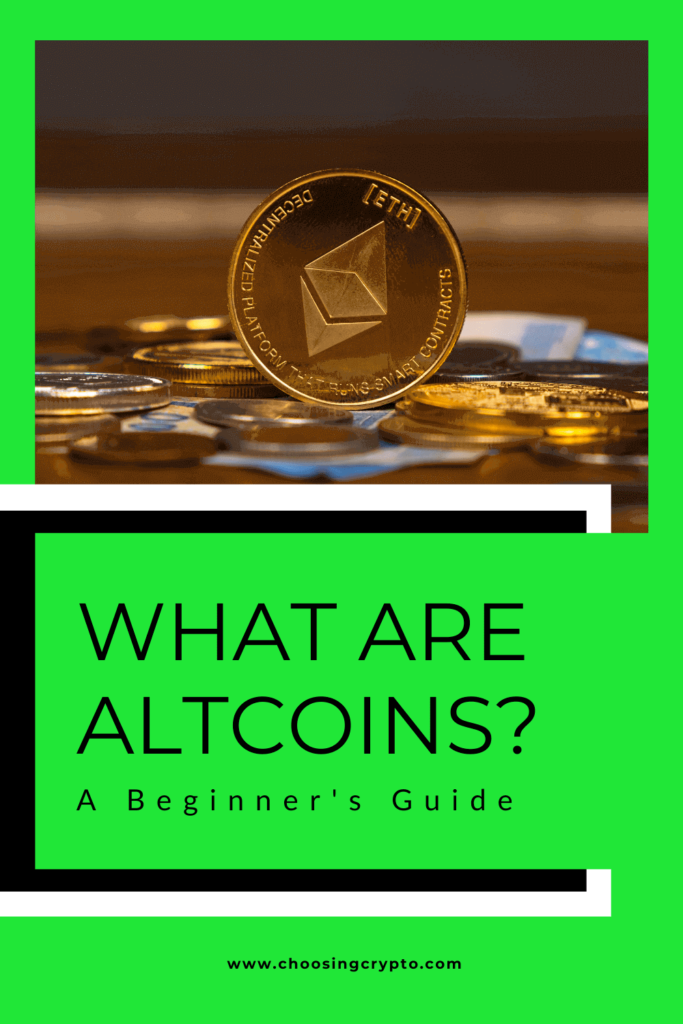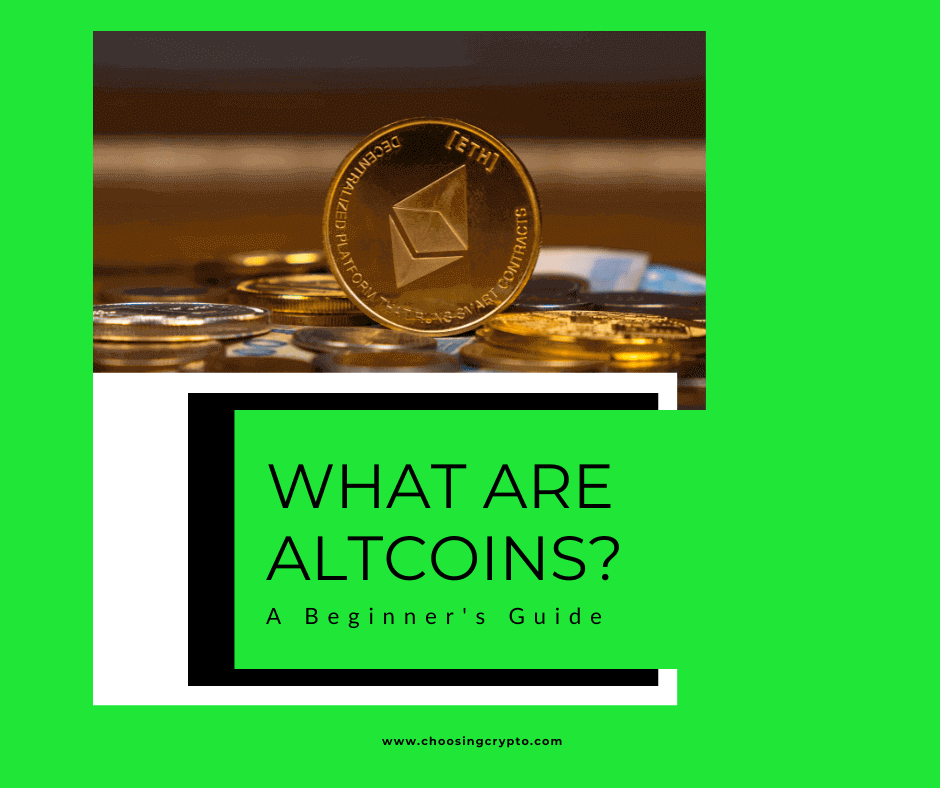Confused about what altcoins are? You’re not alone!
In this easy-to-follow guide, we’ll explain everything you need to know about altcoins. We’ll explain their definition, why they exist, types, popular altcoins, and how to buy them.
Whether you want to understand how they work, are considering investing, or want to impress your friends with your crypto knowledge, you’re in the right place.
What Are Altcoins?
The term “altcoin” is short for “alternative coin.” It refers to any cryptocurrency that is not Bitcoin.
Bitcoin was the first cryptocurrency and is still the most well-known and widely used. Since its launch in 2009, thousands of other cryptocurrencies have emerged.
Altcoins were created to address various limitations and to offer unique features that Bitcoin does not have.
Why Do Altcoins Exist?
Understanding altcoins leads to a natural question: why do they exist? Why not just stick with Bitcoin? The answer lies in the varied needs and goals of the cryptocurrency community. Here are the main reasons altcoins emerged:
1. Innovation and Improvement
Bitcoin was groundbreaking but has its limitations. Developers saw ways to improve Bitcoin’s technology, resulting in the creation of altcoins. For instance, Bitcoin transactions can be slow and costly, especially during high-traffic periods. Some altcoins offer faster transaction speeds, lower fees, and better user privacy.
2. Specific Use Cases
Bitcoin was mainly designed as a digital currency, but many altcoins serve specific purposes beyond just being a medium of exchange. For example, Ethereum introduced smart contracts, which are self-executing contracts with terms written in code. This innovation has led to many decentralized applications (dApps) and services.
3. Diversity and Competition
The existence of numerous altcoins fosters competition and variety in the cryptocurrency market. This competition drives innovation, pushing developers to create better, more efficient, and secure solutions. Like any industry, having multiple options encourages ongoing improvement and evolution.
4. Financial Opportunities
New altcoins also create financial opportunities for investors and developers. Investing in promising altcoins early can lead to significant returns if those coins grow in value.
Types of Altcoins
Altcoins come in many forms, each with unique features and goals. Let’s explore some different categories of altcoins and their key characteristics:
Stablecoins
Stablecoins aim to reduce price fluctuations by linking their value to a stable asset like fiat currency (e.g., USD) or a commodity (e.g., gold). For instance, Tether (USDT) is pegged to the US dollar, meaning 1 USDT is always meant to equal 1 USD, providing a stable store of value.
Privacy Coins
Privacy coins focus on user anonymity and transaction secrecy, making it hard to track transactions on their blockchains. For example, Monero (XMR) uses advanced cryptographic methods to keep transactions private and untraceable.
Utility Tokens
Utility tokens grant access to a product or service within a specific platform. They are not typically used as a general medium of exchange but rather to interact with a particular blockchain project’s ecosystem. For instance, Ethereum (ETH) is used to facilitate transactions and run applications on the Ethereum blockchain, enabling smart contracts and decentralized applications (dApps).
Governance Tokens
Governance tokens give holders voting rights on decisions about the development and operation of a blockchain project or decentralized organization. For example, Uniswap (UNI) tokens allow holders to participate in the governance of the Uniswap protocol, influencing its future direction and changes.
Meme Coins
Meme coins are cryptocurrencies inspired by internet memes or jokes. Though they often start as a parody, some gain significant value and a large following. For instance, Dogecoin (DOGE) was initially created as a spoof of Bitcoin. It has since attracted a loyal community and widespread popularity, often used for tipping and charitable donations.
Each type of altcoin offers unique benefits, addressing various needs within the cryptocurrency ecosystem.
Popular Altcoins You Should Know
Here are some prominent and influential altcoins that have made notable strides in the cryptocurrency space:
1. Ethereum (ETH)
- Overview: Launched in 2015 by Vitalik Buterin, Ethereum is more than just a cryptocurrency. It supports smart contracts and decentralized applications (dApps).
- Unique Feature: The Ethereum Virtual Machine (EVM) lets developers build and deploy smart contracts and dApps, making Ethereum a key platform for many blockchain projects.
2. Ripple (XRP)
- Overview: Developed by Ripple Labs, Ripple is designed for fast and low-cost international money transfers.
- Unique Feature: Ripple uses the Ripple Protocol Consensus Algorithm, which enables quicker transactions and lower fees compared to traditional mining. It’s widely used by financial institutions for cross-border payments.
3. Litecoin (LTC)
- Overview: Created by Charlie Lee in 2011, Litecoin is often called the silver to Bitcoin’s gold. It improves upon Bitcoin’s technology.
- Unique Feature: Litecoin offers faster transaction times and uses the Scrypt hashing algorithm, making it suitable for everyday transactions.
4. Cardano (ADA)
- Overview: Founded by Charles Hoskinson, a co-founder of Ethereum, Cardano aims to build a more secure and scalable blockchain.
- Unique Feature: Cardano uses a proof-of-stake consensus mechanism called Ouroboros, which is more energy-efficient and secure.
5. Polkadot (DOT)
- Overview: Developed by Dr. Gavin Wood, another co-founder of Ethereum, Polkadot aims to enable different blockchains to interact and share information securely.
- Unique Feature: Polkadot’s relay chain allows multiple blockchains, known as parachains, to connect and communicate, promoting interoperability and scalability.
6. Binance Coin (BNB)
- Overview: Initially launched as an ERC-20 token on Ethereum, Binance Coin is the native token of the Binance exchange.
- Unique Feature: BNB can be used to pay for trading fees on Binance at a discount and powers the Binance Smart Chain (BSC), which supports smart contracts and dApps.
7. Chainlink (LINK)
- Overview: Chainlink connects smart contracts with real-world data, bridging blockchain technology and real-world applications.
- Unique Feature: Chainlink uses a decentralized oracle network to provide reliable, tamper-proof data feeds to smart contracts.
8. Stellar (XLM)
- Overview: Stellar aims to facilitate low-cost, cross-border transactions between any currencies.
- Unique Feature: Stellar’s consensus protocol allows for faster and cheaper transactions compared to traditional banking systems, making it ideal for remittances and micropayments.
9. Dogecoin (DOGE)
- Overview: Created as a joke by Billy Markus and Jackson Palmer, Dogecoin has gained popularity due to its active community and use for tipping and donations.
- Unique Feature: Despite starting as a meme coin, Dogecoin has a large supply and low transaction fees, making it popular for small, everyday transactions.
10. Monero (XMR)
- Overview: Launched in 2014, Monero is a privacy-centric cryptocurrency focused on anonymity and decentralization.
- Unique Feature: Monero uses advanced cryptographic techniques to ensure that transaction details and amounts remain private and untraceable.
These altcoins are just some out of many, and each offers unique contributions to the cryptocurrency ecosystem through innovation, specific use cases, or strong community support. Understanding these popular altcoins provides a solid foundation for exploring the diverse world of cryptocurrencies.
How to Buy Altcoins
Now that you understand what altcoins are and know some popular ones, let’s learn how to buy them securely. Follow this step-by-step guide to purchase altcoins:
Step 1: Research the Altcoin
Before buying any altcoin, do thorough research. Look into the team behind it to make sure they are credible. Check the altcoin’s use cases and its growth potential.
Step 2: Choose a Crypto Exchange
To buy an altcoin, you need an account with a cryptocurrency exchange. Ensure the exchange has a good reputation, strong security, and an easy-to-use interface. Some top exchanges are Binance, Gate.io, and Bybit.
Step 3: Create an Account
Register on your chosen exchange. Provide your email address, set a password, and complete any required verification, like KYC (Know Your Customer).
Step 4: Deposit Funds
Most exchanges accept various funding methods, including bank transfers, credit/debit cards, or other cryptocurrencies like Bitcoin or Ethereum.
Step 5: Buy Altcoins
Once your account is funded, go to the trading section of the exchange. Select the altcoin you want to buy, enter the amount, and place your order. You can choose a market order to buy at the current price or a limit order to buy at a specific price.
Additional Resources:
- Best Security Practices for All Cryptocurrency Users
- What You Need to Know Before Investing in Cryptocurrency
- How to Research a Crypto Project Properly
And guess what? We’re also on Instagram and Twitter(X). Join us there for even more fun and useful content!

DISCLAIMER:
The information provided here is for informational purposes only. Do not rely solely on it for making investment decisions. It is not financial, tax, legal, or accounting advice. Always do your own research or consult a financial advisor before investing in cryptocurrency.
